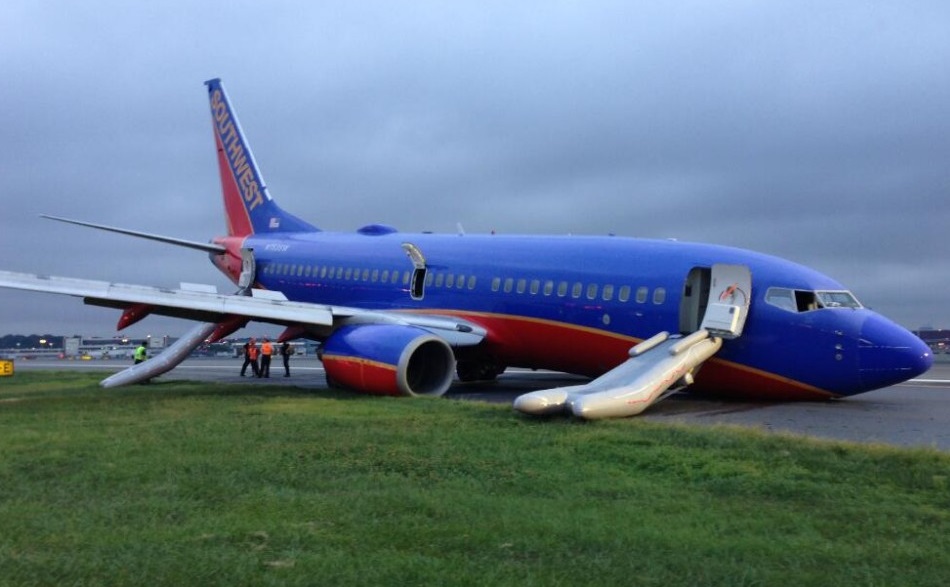Southwest Unstabilised Approach Accident
An unstabilised approach and a late change of control were critical in an accident that resulted in a nose gear collapse at La Guardia say NTSB.
The US National Transportation Safety Board (NTSB) has published their report (DCA13FA131) on a Southwest Airlines (SWA) Flight 34, a Boeing 737-700, N753SW, that had a nose gear collapse during a very hard landing (16 ft/s) on 22 July 2013 at LaGuardia Airport (LGA), New York. The aircraft was substantially damaged (and later scrapped) and 8 occupants were injured.
On the approach they say:
…on final approach, the captain, who was the pilot monitoring (PM), realized that the flaps were not configured as had been briefed, with a setting of 40 degrees for the landing. …the captain set the flaps to 40 degrees as the airplane was descending through about 500 ft altitude, which was about 51 seconds from touchdown.
When the airplane was between 100 to 200 ft altitude, it was above the glideslope. Concerned that the airplane was too high, the captain exclaimed repeatedly “get down” to the first officer about 9 seconds from touchdown. About 3 seconds from touchdown when the airplane was about 27 ft altitude, the captain announced “I got it,”… the control column was relaxed to a neutral position and the throttles were not advanced until about 1 second before touchdown.
The airplane touched down at a descent rate of 960 ft per minute and a nose-down pitch attitude of -3.1 degrees, resulting in the nose gear contacting the runway first and a hard landing.
Southwest B737-700 N753SW at New York-La Guardia Airport, NY after Unstable Approach and NLG Collapse (Credit: NTSB)
The airplane came to a stop on the right side of the runway centerline about 2,500 ft from its initial touchdown.
The Captain, who it has been reported was fired by the airline after the accident, had joined the airline as a First Officer in 2000 (becoming a Captain in 2007) and had around 12,522 hours total flight time, including about 7,909 hours in 737s, of which about 2,659 hours were as Captain. The First Officer joined the airline at the start of 2012 from the USAF and had about 5,200 hours total flight time, including about 1,100 hours in 737s.
The NTSB note that:
The operator’s stabilized approach criteria require an immediate go-around if the airplane flaps or landing gear were not in the final landing configuration by 1,000 ft above the touchdown zone… Further, the airplane’s deviation about the glideslope at 100 to 200 ft would have been another opportunity for the captain, as the PM at this point during the flight, to call for a go-around…
Accident data suggest that pilots often fail to perform a go-around or missed approach when stabilized approach criteria are not met. A review of NTSB-investigated accidents by human factors researchers found that about 75% of accidents were the result of plan continuation errors in which the crew continued an approach despite cues that suggested it should not be continued. Additionally, line operations safety audit data presented at the International Air Safety Summit in 2011 suggested that 97% of unstabilized approaches were continued to landing even though doing so was in violation of companies’ standard operating procedures (SOPs).
The Southwest FOM also states that the captain can take control of the airplane for safety reasons; however, the captain’s decision to take control of the airplane at 27 ft above the ground did not allow her adequate time to correct the airplane’s deteriorating energy state and prevent the nose landing gear from striking the runway. The late transfer of control resulted in neither pilot being able to effectively monitor the airplane’s altitude and attitude… The captain should have called for a go-around when it was apparent that the approach was unstabilized well before the point that she attempted to salvage the landing by taking control of the airplane at a very low altitude.
In addition, the captain did not follow SOPs at several points during the flight. As PM, she should have made the standard callout per the Southwest FOM when the airplane was above glideslope, stating “glideslope” and adding a descriptive word or words to the callout (for example, “one dot high”). Rather than make this callout, however, the captain repeatedly said “get down” to the first officer before stating “I got it.”… The flight crew’s performance was indicative of poor crew resource management.
The NTSB determined the probable cause as:
The captain’s attempt to recover from an unstabilized approach by transferring airplane control at low altitude instead of performing a go-around. Contributing to the accident was the captain’s failure to comply with standard operating procedures.
See also:
Safety Resources
The Flight Safety Foundation (FSF) has published a Briefing Note on Stabilized Approaches and a study A Practical Guide for Improving Flight Path Monitoring.
We have previously published the article Commanders: Flying or Monitoring? and the UK CAA have also set up a microsite ‘Making Monitoring Matter’.
Skybrary has an article on Continuation Bias.
We have also reported on two other relevant occurrences:
- A320 Unstabilised Approach & Descent Below MSA at Lyon
- Dash 8 Tail Strike: Weakness in Stabilised Approach Procedures
UPDATE 10 March 2017: Unstable Approach Dash 8 Touches Down 450ft Before Threshold
UPDATE 9 November 2019: “Shoulda gone around”: B727 Landing with NLG Retracted
UPDATE 13 July 2020: ATR72 Survives Water Impact During Unstabilised Approach
UPDATE 9 December 2020: A Saab 2000 Descended 900 ft Too Low on Approach to Billund
Aerossurance is also pleased to be sponsoring the Chartered Institute of Ergonomics & Human Factors‘ Human Factors in Aviation Safety conference at East Midlands Airport 9-10 November 2015.
Aerossurance has extensive air safety, operations, airworthiness, human factors, aviation regulation and safety analysis experience. For practical aviation advice you can trust, contact us at: enquiries@aerossurance.com
Follow us on LinkedIn and on Twitter @Aerossurance for our latest updates.


Recent Comments